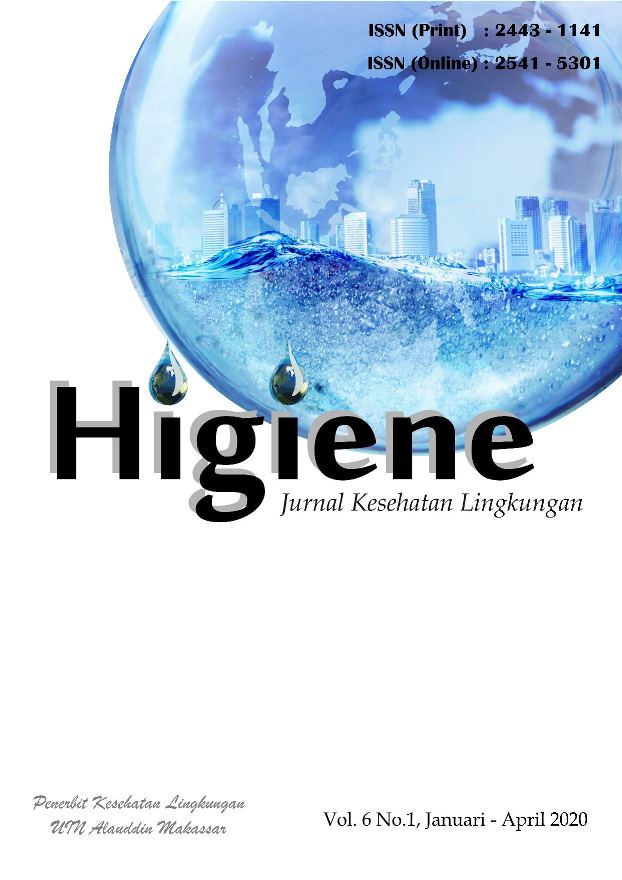Efektivitas Penurunan Kadar Besi (Fe) dan Kekeruhan pada Air Tanah dengan Penambahan Media Kulit Ubi Kayu (Manihot esculenta crantz)
DOI:
https://doi.org/10.24252/higiene.v6i1.14087Abstract
Since water is second most essential element in life after oxygen, the need of clean water never ceases. Clean water must meet certain criteria such as the chemical, physical and biological requirements. The iron content (Fe) in the water is one of the most crucial factors that determines whether the water is safe for use. Most of the residents of Lembo Sub district in Tallo District of Makassar City own wells from which they take the water for their daily use. Apparently, the water contains high level of iron (Fe) and turbidity. Some studies suggest that cassava peels (Manihot esculenta crantz) contain natural substances that can reduce the iron (Fe) content and turbidity of well water. For that reason, this research aims to examine the efficacy of cassava peels (Manihot esculenta crantz) in reducing the iron (Fe) content and turbidity of well water. In investigating the issue, this research used quasi experimental design with Completely Randomised Design (CRD) as the method. The results of statistical analysis suggest that cassava peels can significantly reduce the iron (Fe) content and turbidity of well water, as indicated by significance value of 0.022<0.05 and 0.015<0.05 respectively. The findings show the following statistics. The iron content in the well water before treatment is 5.59 mg/l. After a 15 cm cassava peel treatment, the iron content decreases to 0.03 mg/l on average (99.5%). After a 30 cm cassava treatment, the iron content decreases to 0.046 mg/l on average (99.2%), After a 60 cm cassava peel treatment, the iron content decreases to 0.28 mg/l on average (92%). As for the water turbidity, a 15 cm cassava peel treatment reduces the turbidity level by 1.18 NTU (97.4%), a 30 cm cassava peel treatment reduces the turbidity level by 3.6 NTU (92%), and a 60 cm cassava peel treatment reduces the turbidity level by 1.79 NTU (96.1%). Therefore, this research concludes that cassava peels significantly reduces the iron (Fe) content and turbidity of well water.
Keywords: cassava peels, Iron content, turbidity, groundwater
References
Jumiati, J., Susilawaty, A., & Rusmin, M. (2016). Peningkatan Kualitas Air Sumur Gali Berdasarkan Parameter Besi (Fe) dengan Pemanfaatan Kulit Pisang Kepok. HIGIENE: Jurnal Kesehatan Lingkungan, 1(1), 60-66.
Jusmanizah. (2011). Efektivitas Karbon Aktif Kulit Singkong Dalam Menurunkan Kadar Besi (Fe) dan Mangan (Mn) Air Sumur Gali Di Desa Amplas Kecamatan Percut Sei Tuan Kabupaten Deli Serdang Tahun 2011, Skripsi. Fakultas Kesehatan Masyarakat. Medan : Universitas Sumatera Utara
Krupińska, I. (2019). Removal of Iron and Organic Substances From Groundwater in an Alkaline Medium. Journal of Environmental Engineering and Landscape Management, 27(1), 12–21
Najib, N. (2018). Kontribusi Dan Strategi Pengelolaan Jasa Lingkungan Air Tanah Di Kota Makassar,Skripsi. Sekolah Pacasarjana. Makassar: Universitas Hasanuddin
Rahma. (2013). Pengaruh ketebalan arang tempurung kelapa terhadap tingkat kesadahan air di wilayah kerja puskesmas sudu kabupaten enrekang tahun 2013. Fakultas Ilmu Kesehatan. Makassar: UIN Alauddin
Susilawaty, A. (2015). Peningkatan Kualitas Air Sumur Gali Berdasarkan Parameter Besi (Fe) dengan Pemanfaatan Kulit Pisang Kepok di Dusun Alekanrung Desa Kanrung Kabupaten Sinjai. Al-Sihah : Public Health Science Journal, 7, 166–174.
Utami, S. (2017). Optimalisasi Peran Sains dan Teknologi untuk Mewujudkan Smart City. Banten:Universitas Terbuka
Widowati. (2008). Efek Toksik Logam Pencegahan dan Penanggulangan Pencemaran. Yogyakarta: Penerbit Andi.
Yuliastri, I. (2010). Penggunaan Serbuk Biji Kelor (Moringa oleifera) Sebagai Koagulan dan Flokulan dalam Perbaikan Kualitas Air Limbah dan Air Tanah, Skripsi. Jakarta : Universitas Islam Negeri Syarif Hidayatullah
Downloads
Published
How to Cite
Issue
Section
License
Informasi Hak Cipta
KEBIJAKAN HIGIENE : JURNAL KESEHATAN LINGKUNGAN (AKSES TERBUKA)
Syarat yang harus dipenuhi oleh Penulis sebagai berikut:
- Penulis menyimpan hak cipta dan memberikan jurnal hak penerbitan pertama naskah secara simultan dengan lisensi di bawah Creative Commons Attribution License yang mengizinkan orang lain untuk berbagi pekerjaan dengan sebuah pernyataan kepenulisan pekerjaan dan penerbitan awal di jurnal ini.
- Penulis bisa memasukkan ke dalam penyusunan kontraktual tambahan terpisah untuk distribusi non ekslusif versi kaya terbitan jurnal (contoh: mempostingnya ke repositori institusional atau menerbitkannya dalam sebuah buku), dengan pengakuan penerbitan awalnya di jurnal ini.
- Penulis diizinkan dan didorong untuk mem-posting karya mereka online (contoh: di repositori institusional atau di website mereka) sebelum dan selama proses penyerahan, karena dapat mengarahkan ke pertukaran produktif, seperti halnya sitiran yang lebih awal dan lebih hebat dari karya yang diterbitkan. (Lihat Efek Akses Terbuka).



